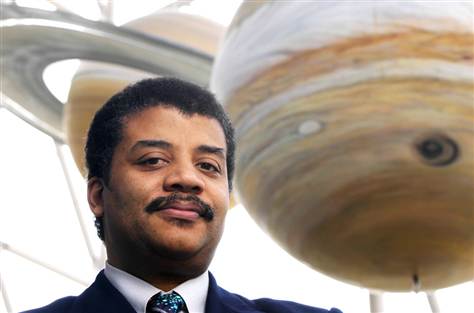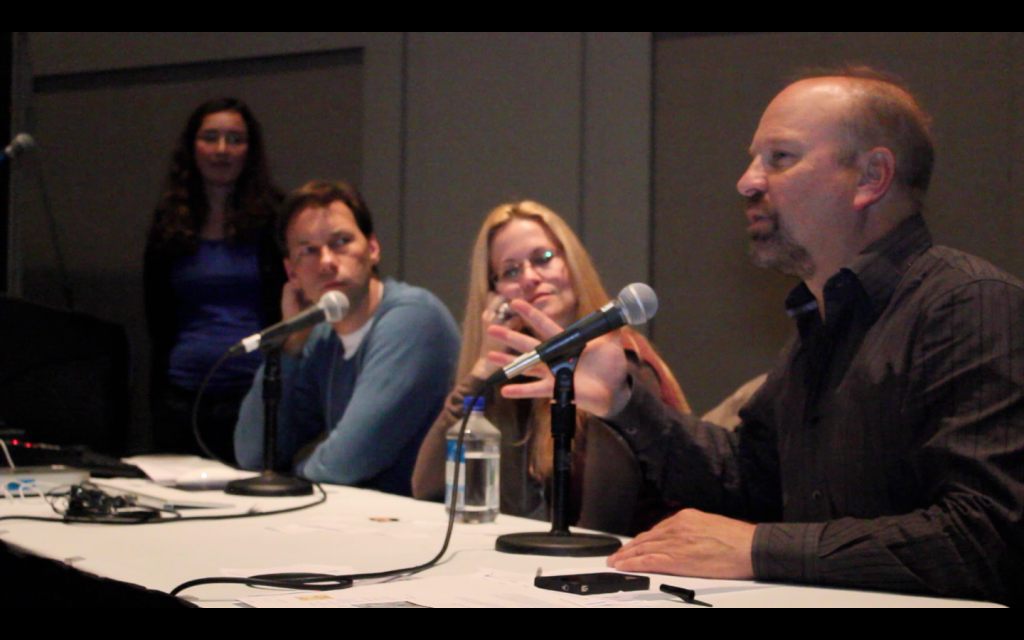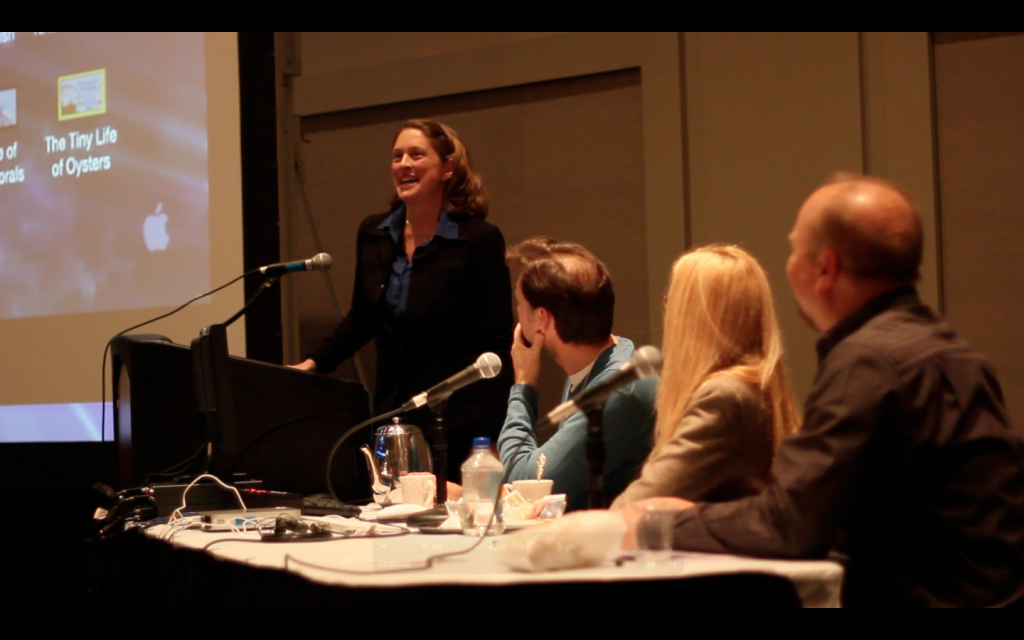#196) Neil Degrasse Tyson: He’s done it again!
February 28th, 2012
How does he do these things? And why is he the only one catching them? And why do people keep saying, “We need another Carl Sagan“? We’ve already got one (only better) with him. NEIL DEGRASSE TYSON was on The Daily Show last night and pointed out that the globe in the opening graphic of the show spins the wrong way. Amazing guy. Amazing mistakes that he catches. How does this happen?
NEIL DEGRASSE TYSON was on The Daily Show last night and pointed out that the globe in the opening graphic of the show spins the wrong way. Amazing guy. Amazing mistakes that he catches. How does this happen?
boom
NEIL DEGRASSE FACT CHECKER
I met Neil Degrasse Tyson a year ago at an event in Hollywood. He was as friendly and hilarious as he is on TV. What a great guy. In my book I tell the story of when he first saw the movie “Titanic,” and noticed the stars were wrong in the night sky above the ship as it’s sinking. He mentioned it to James Cameron and eventually the mistake was corrected. (he tells the story HERE.)
Which leaves you wondering how an army of people working on a $100 million movie like “Titanic” can make such a simple gargantuan mistake.
And then he went and did it again last night at the end of his appearance on The Daily Show. Here were his final words with Jon Stewart …
TYSON: Can I tell you something quick?
STEWART: Yes. Tell us something quick.
TYSON: The beginning of your program … your … your earth is spinning the wrong direction.
STEWART (slamming his book down): Son of a bitch!
TYSON: I’m sorry … I just … I had to get that off my chest.
#195) AMAZING: Scientists who actually LISTEN
February 24th, 2012
At the S FACTOR, we spoke, they listened. What’s up with that?

S FACTOR PANEL MEMBER Brian Palermo offers up advice to Anthony Reisinger of Texas A&M and, like all the science videomakers, miraculously, he LISTENS.
wowzers
A RATHER FASCINATING OBSERVATION
We had such a perfect experience last Sunday with the S Factor panel event at the Ocean Sciences Meeting in Salt Lake city. I’m still trying to make sense of it — why did it work so well? My colleague Dorie Barton, one of the panelists, pointed out a key element the next day. The scientist-videomakers actually LISTENED.
As soon as she said this I realized, “She’s right, they did,” which shouldn’t be that amazing, but it was. I spend a lot of time citing Peter Karieva’s nice review of my book in Science in which he said the one significant shortcoming of the book was it didn’t spend enough time addressing the single biggest problem of scientists — their inability to LISTEN.
Which is true. I didn’t address it enough in the book, and lots of scientists do suffer from this, but not our S Factor participants. Why?
It’s kinda spun my head around and it truly is amazing. There was not a single one of them who haggled with us. No attitude, no defensiveness, no scoffing. They were A-MAZING. None of them had huge egos. ALL of them just admitted they were trying to get a start on making good videos.
interesting
THE VALUE OF SCIENCE SPEAK
I get the terrible feeling what we’re experiencing we’ll some day look back at and call, “the good old days,” — like 5 years from now when EVERY scientist with a video thinks theirs is instantly awesome, and stands at the podium telling us, “Well, you just don’t seem to get what we’re doing.” I suppose it’s inevitable. But for now, it was SUCH a cool experience.
It was probably more fun for the three of us than for the videomakers. It’s called “communication.” It’s just really gratifying to feel heard. I had this feeling last year in Norway in the three day intensive videomaking workshop where the students did the same thing — they LISTENED very closely to all I had to say. So much better than American students on average (I’ve had students in workshop who simply refuse to hear any suggestions on how to make their videos — I offer up advice and they say, “Yeah, well that’s the way YOU would make it, not me.”).
Interesting, interesting, interesting. Why would these videomakers be so much more receptive to input than when I try to talk to scientists about communication in general? Perhaps because they have a specific piece of work we’re talking about which they are wanting to improve. And why would they be better than film school students at managing to not have a gigantic ego? Maybe because they’ve been raised in the clinical processes of the science world where you’re taught to set aside your ego and just deal with the information. This is the upside of speaking in the cold, clinical language of science.
#194) S FACTOR 2 was a big hit at the Ocean Sciences Meeting in SLC
February 21st, 2012
It was a great session and in a couple weeks we’ll have a video version of it.
 THE S FACTOR 2 PANEL AT WORK. From left, actor/improv instructor BRIAN PALERMO, actor/script analyst DORIE BARTON, and me during our 3 hour workshop at the Ocean Sciences meeting where we analyzed and discussed with the filmmakers and audience 10 five minute videos made by scientists. At the podium is Colleen Durkin who made the video, “Jellyfish: A Lifetime of Observation.”
THE S FACTOR 2 PANEL AT WORK. From left, actor/improv instructor BRIAN PALERMO, actor/script analyst DORIE BARTON, and me during our 3 hour workshop at the Ocean Sciences meeting where we analyzed and discussed with the filmmakers and audience 10 five minute videos made by scientists. At the podium is Colleen Durkin who made the video, “Jellyfish: A Lifetime of Observation.”
 Videomaker Elizabeth North talks about her short, “The Tiny Life of Oysters” as the S FACTOR PANEL.
Videomaker Elizabeth North talks about her short, “The Tiny Life of Oysters” as the S FACTOR PANEL.
science
S FACTOR 2 WAS ANOTHER GREAT INTERACTIVE EVENT BETWEEN 3 “HOLLYWOOD” TYPES AND 10 SCIENCE VIDEOMAKERS
It was great. No better word for it. I brought Dorie Barton and Brian Palermo with me as yet another sample of “the voice of Hollywood” to show the science world that not only are there a lot of very smart and friendly folks in Hollywood, they also have a great deal of helpful communication knowledge they are eager to share. We screened and discussed the following 10 videos (in alphabetical order):
Anthony Reisinger – Dead Zone
Matt Oliver – Flat Stanley
Juan Botella – Hydrography in the Southern Ocean
Colleen Durkin – Jellyfish: A Lifetime of Observation
Jason Jones – NASA DEVELOP
Nancy Penrose – Octopus Ballet
Dan Brinkuis/Leslie Peart – Penguin TV
Ari Shapiro – The Scientist Who Stays out in the Cold
Sue Cook – Tale of Two Corals
Elizabeth North – Tiny Oysters
The videos along with their feedback and comments from the panel can be found here. The quality of the videos just keep getting better with each event.
shrimp
A MOVIE IS WRITTEN THREE TIMES
If I had to offer up one general overview piece of advice (which hit me for the first time with this event) it’s that everyone needs to start thinking more about the advance work in making a video — namely scripting. Lots of the videos are made from footage shot during cruises or field projects where, after the fact, the videomaker sits down to figure out how to put it all together into something understandable. Which is great and fine, but the next level is to start writing the script BEFORE you shoot anything, and have your story worked out BEFORE you begin rolling the camera.
Not that you can’t assemble stories after the fact — documentary filmmakers do it all the time, and it’s my preferred mode for the most part. But … you want to make a really good film? You need to find a story, shape it, then shoot it.
It is often said that, “A movie is written three times — first as the script, then during the filming, then again during editing.” My overall advice from this session is for everyone to put a little more effort now into that first part.
#193) Every (Oscar) Party Needs a Pooper, that’s why they Invited Me (the scientist)
February 20th, 2012
I don’t mean to be “the Randy” of this Oscar season, but “The Artist” could have been much more. It’s an example of “shifting baselines” in the film world. You are hereby ordered by law to love and rave about this movie being one of the all-time great achievements in the history of cinema even though it shows no evidence of knowing that there was once a time when silent movies actually told complex, sophisticated stories, instead of a bunch of vague silliness.
You are hereby ordered by law to love and rave about this movie being one of the all-time great achievements in the history of cinema even though it shows no evidence of knowing that there was once a time when silent movies actually told complex, sophisticated stories, instead of a bunch of vague silliness.
silly
SHIFTING THE CINEMATIC BASELINES
Okay, I hate to be “the Randy” of the film world (a reference to the anecdote in my book where I tell about being the “Debbie Downer” of Hollywood parties by ruining people’s fun with the truth), but … “The Artist” is nowhere close to the sort of masterpiece it is being heralded as.
You’re hearing Oscar audiences swooning over the new (largely) silent movie, “The Artist,” as they grind their loins in ecstasy over it’s supposed “cinematic achievements.” But they are setting the bar low resulting in a case of “shifting baselines” for film criticism (meaning losing track of past standards).
I saw a screening of the movie a last fall here in L.A. with the actor James Cromwell (who is in it) speaking afterwards. The first thing he conceded is, “Well, yes, the story is very simple.” Simple? That’s an understatement. Try Mickey Mouse. It’s boy meets girl, boy gives girl big break, girl skyrockets and forgets boy, yadda, yadda. A story that’s been told a million times. NOTHING interesting. Just a little novelty tribute to the past, which is nice, but let’s keep things in perspective.
boo
BUSTER KEATON IS ROLLING IN HIS GRAVE
Yes, it is 100% excellent in terms of technique such as music scoring (which is splendid) and cinematography (flawless). But why shouldn’t it be? In this era, given today’s technology? Big whoop. A bunch of high school kids with After Effects on their iMac can do the same today in their garage. Technology is no longer the artistic challenge. The challenge is the storytelling.
And that’s where it, I guess, reveals that the filmmakers just didn’t watch many genuine silent movies.
But we did in film school. “The History of Silent Cinema,” was the first course we were required to take during our first semester at U.S.C. film school, and we were lucky enough to have David Shepherd, one of the world’s best film preservationists, as our instructor (I was subsequently unlucky enough to have him be one of the first to critique my musical comedy student film which he crapped on worse than anyone else, oh, well).
In that course we got to see the highs and lows of much of the silent film era. The lows consisted of some movies that put me into sleep comas so deep I didn’t even know who I was when awoke.
But the highs … they were truly incredible. He showed us films that just made you sit up and say, “Oh, my goodness, I had NO idea they could tell such complex, subtle, and sophisticated stories back then, and all without any sound effects or dialogue.”
Here’s two examples I recall. “The Musketeers of Pig Alley,” by D.W. Griffith was made in frickin’ 1912 — it’s about to be 100 years old! It is an AMAZING film and is regarded as the first movie about organized crime — it’s the great, great, great, great grandfather of “Good Fellas.” I still remember the facial expressions of the gangsters conveying all sorts of varieties of anger, suspicion, intimidation. It had multiple storylines and kept you as riveted as any modern crime film.
Another film I was absolutely stunned by was the Russian silent movie of 1927, “Bed and Sofa.” It’s about a couple who lets an out of work friend move in, but when the husband goes away on work, the friend moves from the sofa to the bed, ending up with issues of polygamy and abortion. All in 1927. It was shockingly contemporary in content, and again, very sophisticated storytelling.
So imagine if the filmmakers behind, “The Artist,” had watched a bunch of those old movies and then said to themselves, “Let’s show today’s audiences the state of sophistication that silent movies ended up with,” rather than this bozo piece that they’ve produced. I mean, there’s nothing wrong with having some bozo fun, but seriously, it’s kind of insulting to the past to give today’s audiences the impression that the silent filmmakers never knew how to tell interesting, complex stories.
Buster Keaton, D.W. Griffith, Lillian Gish, Charlie Chaplin, Rex Ingram, and of course all the great Benshi’s of Japan (for whom this site is named) … they are all rolling in silent circles in their graves.
My theme for 2012 is looking increasingly to be, “Who cares about accuracy or the past, we’re headed towards the new dark ages.” Ho hum.
#192) Football: The Grim Reality of Human Risk Aversion
February 7th, 2012
This segment of HBO’s Real Sports with Bryant Gumbel is beyond belief. No football teams should ever punt or kick. The only reason they do is fear of risk taking. Which is sadly relevant to the idea of innovation.
 TRULY AMAZING. This coach, Kevin Kelley of Pulaski Academy did the numbers and figured out something stunning.
TRULY AMAZING. This coach, Kevin Kelley of Pulaski Academy did the numbers and figured out something stunning.
boot
PUNTING IS CONCEDING “OFFENSIVE FAILURE”
I guess it’s sort of what the word means. “To punt,” generally means to give up.
This is one of the most amazing stories I’ve ever heard. I’m a huge fan of HBO’s Real Sports with Bryant Gumbel. You want to talk about storytelling, this is a show that has mastered it. They do such a good job, you end up not even caring what sport any given segment is about because you know that even if it’s about the World Badminton Championships, they are going to tell you some human story that will leave you either shaking your head in amazement, laughing hysterically, or with tears in your eyes. They are masters at it.
So last week they had one of the most incredible stories ever. It is about Kevin Kelley, football coach for Pulaski Academy high school in Arkansas. He began questioning the wisdom of punting on fourth down, and kicking away on the kickoff. His stunning conclusion, supported by the data, is that you shouldn’t ever do either. The numbers show you will do better in the long run by always going for it on fourth down and always doing an onside kick for the kickoff.
He’s been doing this for several years. They no longer even have a punter, and their kickoff teams have come up with a dozen variations for the onside kick. The result — three state championships in six years.
wow
CHICKEN BALL
In this wild segment, which they open by comparing it to the recent movie, “Moneyball,” they bring in the statisticians who agree with his conclusions. And then they ask the obvious question, “Why don’t ALL football teams follow this strategy?”
The simple and sad answer is risk aversion. Even though the numbers say you should do these things, most teams don’t. The reason is that both calls — going for it on fourth down and doing the onside kick — are perceived by the fans as highly risky. Even though they aren’t. But once again, perception is everything.
In the segment one statistician says he analyzed 3,000 circumstances in pro football when the teams should have gone for it on fourth down. But in fact only 4 percent of the time did they do it. The rest of the time they just went ahead with punting simply because it is perceived as the correct move. They didn’t want to do what is perceived as the risky move, even though it isn’t.
It’s both amazing and depressing. People are risk averse by nature.
Which brings us back to the problem with innovation. Everybody talks a big story about wanting to be innovative, but when they actually look at the supposed risk involved, they opt to do what is perceived as the safe thing. They would rather be risk averse and concede how boring things are than to actually take any chances. The human deck is stacked against innovation.
boot
THE CEREBRAL VS. VISCERAL DIVIDE
I’ve been spending a lot of time lately complaining about the lack of willingness of the science community to dig deeper into the visceral/intuitive side of communication. And I stick with that complaint. But that said, this is an example of the opposite situation. This is a sport that is so deeply invested in the intuitive/gut instinct side of decision making that it is unable to actually yield to the cerebralists with their data. Which is fascinating.
Here’s the synopsis of the Real Sports segment:
Between the Numbers
Producer: Nick Dolin
Kevin Kelley, head football coach at Pulaski Academy in Little Rock, Ark., uses his own research to back up the mantra that his team should never punt, should always kick onside kicks after a score and should never return punts. If this sounds too unorthodox to be effective, Kelley’s theories have resulted in a 104-19 record since he became head coach at the high school, and statisticians have supported his theory on the relative value of punting. REAL SPORTS correspondent Jon Frankel visits the 42-year-old Kelley in Little Rock as his team prepares to seek its third state title under his leadership.
#191) Jason Ensler’s Tribute to Ben Gazzara: Storytelling at its best
February 6th, 2012
Great insights into famous people often come from the not-yet-famous people around them. This is a prime example.
 BEN GAZZARA – A great actor with a fittingly great tribute to him from a former line coach.
BEN GAZZARA – A great actor with a fittingly great tribute to him from a former line coach.
boom
PERSONAL STORY FROM A STORYTELLER
My film school classmate and Hollywood buddy Jason Ensler, who was such an outstanding contributor to our first S FACTOR panel at the AGU meeting in December, posted this neat little tribute to actor Ben Gazzara yesterday. It’s both funny and touching — the work of a skilled storyteller.
#190) Jonah Lehrer Takes a Narrow (and faulty) Look at Brainstorming in this week’s New Yorker
February 3rd, 2012
He throws the brainstorming baby out with the bathwater. He fails to make any mention whatsoever of the massively overwhelming power of negation. Just look at this week’s Florida primary where 92% of the political ads were negative. We are naturally susceptible towards moving in the negative, cautious, or conservative direction. Brainstorming is a method to offset this. It’s not a panacea, it has clearly been over-hyped in the past, but it works and is essential to innovation.
 Jonah Lehrer is a great troublemaker. The only problem: his critiques tend to be kinda piecemeal.
Jonah Lehrer is a great troublemaker. The only problem: his critiques tend to be kinda piecemeal.
oops
NEGATION IS NOT NOTHING
I was a fan of Jonah Lehrer’s New Yorker article in the fall of 2010 on “the decline effect.” He did a good job of pointing out some of the weaknesses of “the scientific method” in an information overloaded society (though plenty of scientists were irked by his article). But I think he’s written a somewhat trivial critique this past week on “brainstorming.”
He makes some interesting points in the article — such as the trend in research towards team efforts rather than individuals (but isn’t that the same as going from start-up businesses to major corporations?) and the fact that a mixture of brainstorming and critical thinking – a sort of “critical ideation” process — works best, and that social interactions (which can be enhanced by proximity or workspace layout) matter when it comes to creativity. All of which are fine.
But there’s no discussion of the innate draw people have towards negativity (as evidenced by the outlandish 92% negative ads in Florida for this week’s Republican primary), and the MYOPIA it leads to. He says, “The underlying assumption of brainstorming is that if people are scared of saying the wrong thing, they’ll end up saying nothing at all.” Yeah, well, that’s one underlying assumption. But the more important underlying assumption is that letting the negative/negating/critical voice go unchecked will end up reducing the VARIATION of ideas that get considered, running the risk of missing key solutions, and more importantly squelching innovation.
oo
IMPROV ACTORS POSITIVELY UNDERSTAND THIS
This is the strength and value of improv acting techniques. I’ve taken classes at Second City, Acme and worked for a decade with The Groundlings (did I mention that 3 of the 4 actors in our Senate Coral Hearing film are up for Oscars this year?! though let’s be clear, I doubt any of them remember doing the little film in 2004). This month I’m bringing veteran improv actors/instructors Jeremy Rowley with me to New Orleans for the workshops we do with doctors for Society for Hospital Leadership, and Brian Palermo to Salt Lake City for our S Factor 2 panel.
I’ve learned a great deal from these folks. Improv is much more than just a bunch of silly icebreaker games. There’s a mechanical/physiological component to it. Improv and “brainstorming” are pretty much the same process, but I think the improv folks have developed a clearer, better articulated understanding of why it is important. They understand the mechanical value of what it does in terms of bringing you down “out of your head,” adding the spark of spontaneity, and allowing ideas to grow into something larger than what you start with. And the fundamental rule of improv, just like brainstorming, is no negation, only affirmation.
There’s a reason these guys are constantly hired by major corporations to work with their creative teams. And they are brought in by Dreamworks as Jeremy Rowley talked about last year in my interview with him.
pun
BOTTOM LINE: DON’T MYTH OUT ON BRAINSTORMING
Lehrer (or his editors) subtitled his article, “The Brainstorming Myth.” That’s a bit of an exaggeration. The term “brainstorming” has come to mean the general idea of getting people together to increase the VARIATION in the ideas being considered. It is valuable in offsetting the inevitable drift towards negation. This is the perspective he gave little attention to in the article. Yes, it may have been over-hyped in it’s early years as a single activity that leads to brilliance, but that’s no reason to try and imply it doesn’t work and is some fallacy that millions are still buying into.
The simple fact is that excessive negation, which is what you get inevitably from heavily cerebral types, will eventually lead to a loss of variation causing a loss of creativity and thus a lack of innovation. I’ve seen this at an introductory level with the videomaking workshops I conduct. I’ve run ten of them over the past six years — 7 with grad students, 3 with undergrads. Guess which group is more creative with their initial ideas? My producer Ty Carlisle and I were blown away the first time we ran the workshop with undergraduates at USC’s Wrigley Institute — their level of hugely energetic creativity in their pitches was about double that of all the previous groups of grad students. As they gave their pitches Ty and I kept looking at each other, kinda stunned.
Ultimately, heavily educated folks produce the most rigorous and important work. We know that. It’s no surprise. But they also inevitably work themselves into a constrained, overly-critical, overly-negated box of limited variation. Brainstorming, however it is conducted, is a means through which to combat this inexorable narrowing process.
Lehrer missed this central point on brainstorming. As punishment he needs to spend a year in improv classes.
#189) Our New S FACTOR Website
February 2nd, 2012
Make your science video AWESOME!

JOIN US FOR THE NEXT S FACTOR PANEL in Salt Lake City at the Ocean Sciences Meeting, Sunday afternoon, Feb. 19.
bold
NEW WEBSITE
If you’re going to the Ocean Sciences Meeting in Salt Lake City, don’t forget that if you have a 5 minute video to submit to our S Factor 2 panel. The DEADLINE is tomorrow, February 3rd. And keep in mind, it’s not a competitive event — we select a wide range of good and not-so-good videos for our analysis. Which means that it means nothing if your video isn’t chosen. It’s just a chance to have the entire group — the panel of three filmmakers, plus the entire audience — talk about your film, which is both fun and productive.
In the meanwhile, HERE’S the new website we’ve put together for this and future S Factor panels.
#188) New Twitter Address: @thebenshi
February 1st, 2012
Yes, I do still have at least some ability to LISTEN …

TIME FOR A NEW NAME. People spoke, I listened. Please join us at the new name: @thebenshi
I swear I love the Twitter and wish I could sit on it all day long Tweeting my brains out. And yet … how in the world does anyone find time for that stuff?
That’s all I can think every time I open up my Tweetdeck. Like the scene in Caddyshack where Rodney says to all the old men in the clubhouse playing poker, “Don’t you people have homes?” (which resonated so deeply with all my childhood friends in Kansas — we grew up in a lake community with a golf course and club house that had the exact same set of old men in the poker room playing cards at all hours of the day and night causing us to say the same thing — don’t you people have homes?).
How do people find the time to sit there and Tweet all day long? I guess maybe they’re at their desks with it open. A different work mode than I.
Oh, well, I do think it’s incredibly cool. And I unfortunately started Tweeting with a major misstep by concocting a long and clumsy name which several people have pointed out to me. So Josh (the 23 yr old filmmaker superstar who runs our Prairie Starfish office at Raleigh Studios) and I have switched it to a more simple name which is, “@thebenshi”
Pleeease join us at this new address, and I promise to try and be more interesting on Twitter this year.